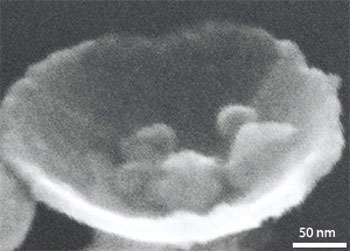| Aug 08, 2011 |
Magnetic nickel nanobowls induce the perfect planar alignment of liquid crystals
|
|
(Nanowerk News) Liquid crystal displays (LCDs) are now used ubiquitously in devices such as computer monitors, televisions screens and mobile phones. As the performance and properties of such displays are determined to a large extent by how well the LC molecules line up in display cells and their orientation, scientists are constantly striving to develop simple methods to induce these molecules to align uniformly in the desired direction. The addition of nanoparticles has been used to align LCs vertically, but little consideration has been given to other alignments or the effect of nanoparticle shape on alignment direction.
|
|
Lin Guo and colleagues from Beihang University in Beijing, China, have now achieved perfect vertical and planar alignments of LCs using nickel nanoparticles with different morphologies ("Synthesis of Nickel Bowl-like Nanoparticles and Their Doping for Inducing Planar Alignment of a Nematic Liquid Crystal").
|
 |
| Scanning electron microscopy image of nickel 'nanobowls'. (© 2011 ACS)
|
|
Using a polarized optical microscope, the team observed that 'doping' LCs with bowl-shaped nickel nanoparticles (pictured) induces a planar alignment of the LCs, whereas other structures, such as 'nanoflowers' and 'nanospheres', caused the LCs to align vertically. "We have discovered a new phenomenon," explains Guo. "By adjusting the structure of the nanoparticles used to dope the LCs, we can control the alignment pattern."
|
|
Guo suggests that there is a combination of reasons for the planar alignment of LCs when doped with the 'nanobowls'. Firstly, the bowl-like shape prefers to align in a planar chain-like fashion, as opposed to stacking one on top of the other. The magnetic property of the nickel nanobowls also favors planar alignment. The aligned nanoparticles then induce the nearby LC molecules to follow the same orientation.
|
|
Both of these properties need to be present for planar alignment to occur. The flower- and sphere-like nickel nanoparticles, on the other hand, induced the LCs to line up vertically. "If we use non-magnetic bowls instead, the nanoparticles might form structures of single bowls or even stacked bowls," adds Guo.
|
|
The next step for Guo's team is to investigate the detailed mechanism responsible for these alignment effects. "We will be continuing study the relationship between nanostructure and alignment pattern," says Guo. "The end goal is to find the ideal component and structure to induce the desired alignment of LCs."
|

